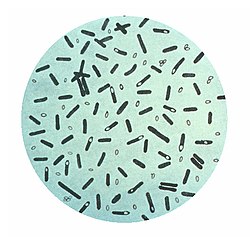クロストリジウム綱
| クロストリジウム綱 | |||||||||
|---|---|---|---|---|---|---|---|---|---|

| |||||||||
| 分類 | |||||||||
| |||||||||
| 学名 | |||||||||
| Clostridia Rainey 2010[1] (IJSEMリストに掲載 2010[2]) | |||||||||
| シノニム | |||||||||
| 下位分類(目)[19] | |||||||||
|
クロストリジウム綱(Clostridia)は、タイプ属としてクロストリジウム属(Clostridium)、タイプ目としてクロストリジウム目(Clostridiales)を含む、高度な多系統群であるフィルミクテス門の綱である。クロストリジウム綱は好気性呼吸がないことによってバシラス綱と区別される。クロストリジウム綱は、偏性嫌気性菌であり、酸素はクロストリジウム綱に有毒である。 クロストリジウム属の種は、しばしばグラム陽性ではないが、芽胞形成する能力を有する[20]。研究によると、クロストリジウム属は単系統群ではなく、その関係は完全には分かっていない。現在のところ、ほとんどがクロストリジウム目に置かれているが、これには不確定な要素があり、将来再定義される可能性がある。 クロストリジウム属のほとんどの種は、環境中の多くの場所、特に土壌中に見いだされる腐生生物である。しかし、その属にはいくつかのヒト病原体(以下に概説)が含まれている。クロストリジウム属の特定の種によって産生される毒素は、最も危険なものとして知られている。破傷風菌によって産生される破傷風毒素(テタノスパスミンとして知られている)およびボツリヌス菌によって産生されるボツリヌス毒素(ボツリヌストキシン)が例として挙げられる。いくつかの種は、細菌性膣炎を有する女性から単離されている[21]。 この綱に属する注目すべき種は次のとおりである:
- ウェルシュ菌(Clostridium perfringens)(壊疽、食中毒)
- クロストリディオイデス・ディフィシル(Clostridioides difficile)(クロストリジウム・ディフィシル腸炎)
- 破傷風菌(Clostridium tetani)(破傷風)
- ボツリヌス菌(Clostridium botulinum)(ボツリヌス中毒症)
- Clostridium acetobutylicum
- Clostridium haemolyticum
- Clostridium novyi
- Clostridium oedematiens
ヘリオバクテリア(Heliobacteria)とChristensenellaもクロストリジウム綱に属する種である。 この群によって産生される酵素のいくつかは、バイオレメディエーションで使用されている。
疫学[編集]
クロストリジウム綱に属する菌は、土壌やヒトや動物の腸内細菌などによく見られるため、世界中でクロストリジウム綱による傷害や感染症が見出されている。微生物に対する宿主防御はほとんど存在せず、自然免疫はほとんど存在しない。クロストリジウム綱は、感染組織の病変の特徴及び細菌培養のグラム染色によって診断することができる[20]。身体は十分な防御力を持っていないが、この細菌はペニシリンのような抗生物質とより重篤な症例を防止するためのデブリードマン(感染、壊死組織の除去処置)の助けを借りて制御することができる。
脚注[編集]
- ^ Rainey FA. (2009). “Class II. Clostridia class nov.”. In De Vos P, Garrity GM, Jones D, Krieg NR, Ludwig W, Rainey FA, K.-H. S, Whitman WB. Bergey's Manual of Systematic Bacteriology, 2nd edn, vol. 3 (The Firmicutes). Springer (New York). p. 736
- ^ a b “List of new names and new combinations previously effectively, but not validly, published”. International Journal of Systematic and Evolutionary Microbiology 60 (3): 469-472. (01 March 2010). doi:10.1099/ijs.0.022855-0.
- ^ Sorokin DY, Merkel AY (03 December 2021). “Desulfitisporia class. nov.”. In Whitman WB. Bergey's Manual of Systematics of Archaea and Bacteria. Wiley. pp. 1-2. doi:10.1002/9781118960608.cbm00088
- ^ Evgenii N. Frolov, Alexander V. Lebedinsky, Alexander G. Elcheninov, Ilya V. Kublanov (January 2023). “Taxonomic proposal for a deep branching bacterial phylogenetic lineage: transfer of the family Thermodesulfobiaceae to Thermodesulfobiales ord. nov., Thermodesulfobiia classis nov. and Thermodesulfobiota phyl. nov”. Systematic and Applied Microbiology 46 (1): 126388. doi:10.1016/j.syapm.2022.126388. PMID 36493506.
- ^ a b Thomas Cavalier-Smith & Ema E-Yung Chao (03 January 2020). “Multidomain ribosomal protein trees and the planctobacterial origin of neomura (eukaryotes, archaebacteria)”. Protoplasma 257: 621–753. doi:10.1007/s00709-019-01442-7. PMC 7203096. PMID 31900730.
- ^ Watanabe M, Fukui M, Kuever J (15 October 2019). “Desulfocucumaceae fam. nov.”. In Anonymous NNe. Bergey's Manual of Systematics of Archaea and Bacteria.. John Wiley & Sons (New York). pp. 1-2. doi:10.1002/9781118960608.fbm00348
- ^ Dimitry Y. Sorokin, Martijn Diender, Alexander Y. Merkel, Michel Koenen, Nicole J. Bale, Martin Pabst, Jaap S. Sinninghe Damsté, Diana Z. Sousa (July 2021). “Natranaerofaba carboxydovora gen. nov., sp. nov., an extremely haloalkaliphilic CO-utilizing acetogen from a hypersaline soda lake representing a novel deep phylogenetic lineage in the class ‘Natranaerobiia’”. Environmental Microbiology 23 (7): 3460-3476. doi:10.1111/1462-2920.15241. PMC 8359318. PMID 32955149.
- ^ R. E. Buchanan (1 July 1917). “Studies on the Nomenclature and Classification of the Bacteria: III. The Families of the Eubacteriales”. Journal of Bacteriology 2 (4): 347-50. doi:10.1128/jb.2.4.347-350.1917. PMC 378713. PMID 16558750.
- ^ V. B. D. Skerman, Vicki. McGOWAN, P. H. A. Sneath (01 January 1980). “Approved Lists of Bacterial Names”. International Journal of Systematic and Evolutionary Microbiology 30 (1): 225-420. doi:10.1099/00207713-30-1-225.
- ^ Frederick A. Rainey, Tatjana N. Zhilina, Eugenia S. Boulygina, Erko Stackebrandt, Tatjana P. Tourova, George A. Zavarzin (August 1995). “The Taxonomic Status of the Fermentative Halophilic Anaerobic Bacteria: Description of Haloanaerobiales ord. nov., Halobacteroidaceae fam. nov., Orenia gen. nov. and further Taxonomic Rearrangements at the Genus and Species Level”. Anaerobe 1 (4): 185-199. doi:10.1006/anae.1995.1018. PMID 16887527.
- ^ “Validation of the Publication of New Names and New Combinations Previously Effectively Published Outside the IJSB”. International Journal of Systematic and Evolutionary Microbiology 45 (4): 879-880. (01 October 1995). doi:10.1099/00207713-45-4-879.
- ^ Sachiko Sakamoto, Masaru K Nobu, Daisuke Mayumi, Satoshi Tamazawa, Hiroyuki Kusada, Hideharu Yonebayashi, Hiroki Iwama, Masayuki Ikarashi, Tatsuki Wakayama, Haruo Maeda, Susumu Sakata, Tomohiro Tamura, Nobuhiko Nomura, Yoichi Kamagata, Hideyuki Tamaki (January 2021). “Koleobacter methoxysyntrophicus gen. nov., sp. nov., a novel anaerobic bacterium isolated from deep subsurface oil field and proposal of Koleobacteraceae fam. nov. and Koleobacterales ord. nov. within the class Clostridia of the phylum Firmicutes”. Systematic and Applied Microbiology 44 (1): 126154. doi:10.1016/j.syapm.2020.126154. PMID 33227632.
- ^ Aharon Oren, George M. Garrity (02 August 2021). “Valid publication of new names and new combinations effectively published outside the IJSEM”. International Journal of Systematic and Evolutionary Microbiology 71 (7): 4846. doi:10.1099/ijsem.0.004846.
- ^ Noha M. Mesbah, David B. Hedrick, Aaron D. Peacock, Manfred Rohde, Juergen Wiegel (01 November 2007). “Natranaerobius thermophilus gen. nov., sp. nov., a halophilic, alkalithermophilic bacterium from soda lakes of the Wadi An Natrun, Egypt, and proposal of Natranaerobiaceae fam. nov. and Natranaerobiales ord. nov.”. International Journal of Systematic and Evolutionary Microbiology 57 (11): 2507-2512. doi:10.1099/ijs.0.65068-0. PMID 17978210.
- ^ “Notification that new names and new combinations have appeared in volume 57, part 11, of the IJSEM”. International Journal of Systematic and Evolutionary Microbiology 58 (2): 313-314. (01 February 2008). doi:10.1099/ijs.0.65804-0.
- ^ Wiegel J. (2009). “Order III. Thermoanaerobacterales ord. nov.”. In De Vos P, Garrity GM, Jones D, Krieg NR, Ludwig W, Rainey FA, K.-H. S, Whitman WB. Bergey's Manual of Systematic Bacteriology, 2nd edn, vol. 3 (The Firmicutes). Springer (New York). p. 1224
- ^ Xue Zhang, Bo Tu, Xiao-meng Lv, Paul A. Lawson, Min Yang, Li-rong Dai, Hui Zhang, Yue-Qin Tang, Yu Deng, Lei Cheng (01 December 2019). “Description of Biomaibacter acetigenes gen. nov., sp. nov., and proposal of Thermosediminibacterales ord. nov. containing two novel families of Tepidanaerobacteraceae fam. nov. and Thermosediminibacteraceae fam. nov.”. International Journal of Systematic and Evolutionary Microbiology 69 (12): 3891-3902. doi:10.1099/ijsem.0.003701. PMID 31513009.
- ^ “Notification that new names of prokaryotes, new combinations, and new taxonomic opinions have appeared in volume 69, part 12 of the IJSEM author=Aharon Oren, George M. Garrity”. International Journal of Systematic and Evolutionary Microbiology 70 (3): 1447-1449. (31 March 2020). doi:10.1099/ijsem.0.003992.
- ^ “Class Clostridia”. List of Prokaryotic names with Standing in Nomenclature. 2023年3月23日閲覧。
- ^ a b Baron, Samuel (1996). Medical Microbiology (4 ed.). Galveston: Universirt of Texas Medical Branch. ISBN 0-9631172-1-1
- ^ Africa, Charlene; Nel, Janske; Stemmet, Megan (2014). “Anaerobes and Bacterial Vaginosis in Pregnancy: Virulence Factors Contributing to Vaginal Colonisation”. International Journal of Environmental Research and Public Health 11 (7): 6979–7000. doi:10.3390/ijerph110706979. ISSN 1660-4601. PMC 4113856. PMID 25014248.
